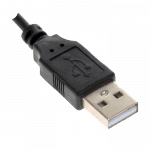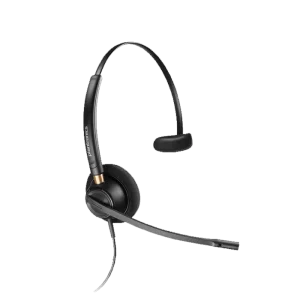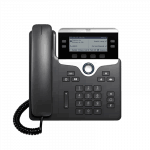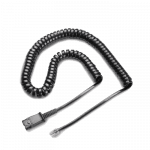Cisco Headsets – Everything You Need to Know for Cisco Telephones

Headsets for Cisco Phones
Cisco is a leading telephone company and has done an excellent job integrating telephone headset usage into their standard Cisco telephones and Cisco IP Communicator softphones. Numerous headsets are compatible with Cisco telephones, but finding the correct amplifier or direct-connect cable is the key to getting a headset to work properly with your Cisco phone.
The following guide will explain the compatible equipment you need, including many pictures to simplify the process of finding a Cisco headset for your application.
Last Updated – January 2025
Headsets for Cisco Phones as easy as 1-2-3
Understanding This Guide and Headset Connectivity (3 minutes):
Step 1: Decide Between Wireless Headsets and Wired Headsets
Wireless Headset Advantages:
- More Productive Taking Calls Where You Need To Go
- Remote Call Alerts
- Answer/Hang up Remotely
- No Wires to Manage/Trip Over/Limit Reach
- More Advanced Technology/Audio Features Than Wired
Wired Headset Advantages:
- Less Expensive Than Wireless
- No Batteries/Charging
- Simple to Setup and Use
Step 2: Understanding What You Need
 Wireless Headsets:
Wireless Headsets:
Business grade wireless headsets for Cisco come in many different wearing styles, with different talk-times (battery life), covering different distances, and technological features. Once you choose the style, talk-time and distance to cover your needs you will have everything you need for basic operation.
On older Cisco phones, you will turn the headset on/off for each call and start/end all of your calls back at your phone. Too greatly improve your experience with a wireless headset, most users also purchase an EHS cable or lifter to automate the process of handling calls, preserving battery and remote capabilities.
KEY POINT: Remote call alerts and answering/hanging up remotely require an EHS cable or lifter.
On newer Cisco phones, you will find a built-in USB port and Bluetooth connectivity. This allows for use of USB and Bluetooth wireless headsets and eliminate the need for an additional EHS cable or lifter for remote capabilities. It’s now built into the phone.

KEY POINT: Newer Cisco phones have USB ports and will allow remote alerts and answering/hanging up without an EHS cable or lifter.
To determine EHS cable/lifter options, use our Cisco Headset Compatibility Chart below. For more info visit: Understanding a Wireless Cisco Headset Solution

Wired Headsets:
Business grade wired headsets for Cisco come in many different wearing styles and technological features. You choose the style and features you need to best suit your personal preferences (headband versus ear models) and environment (dual ear and noise canceling capabilities). These headsets will have a Quick-Disconnect at the end of the cord that will connect to a Direct Connect bottom cable or amplifier. Many newer phones with a USB port will now support use of headsets with USB connections.
KEY POINT: A wired headset requires a Direct Connect cable or amplifier. (Learn about Quick-Disconnect)
KEY POINT: Newer Cisco phones have USB ports and will allow headsets with USB connections to work perfectly.
 Numerous Direct Connect cables are available, each made for specific phone models. Amplifiers provide the best audio, and are more universal allowing customization of microphone and speaker volumes. To find which Direct Connect cable or amplifier you need for your specific Cisco phone, use our Cisco Headset Compatibility Chart below. Combining a headset with a compatible Direct Connect cable or amplifier will provide you with everything you need. For more info visit: Understanding a Wired Cisco Headset Solution
Numerous Direct Connect cables are available, each made for specific phone models. Amplifiers provide the best audio, and are more universal allowing customization of microphone and speaker volumes. To find which Direct Connect cable or amplifier you need for your specific Cisco phone, use our Cisco Headset Compatibility Chart below. Combining a headset with a compatible Direct Connect cable or amplifier will provide you with everything you need. For more info visit: Understanding a Wired Cisco Headset Solution
Step 3: Most Common Solutions – Add to Cart and You’re Good To Go!
Poly (Formerly Plantronics) Wireless Headset Solutions:
-
$228.37
 Poly Voyager 4245 Office Convertible Headset(Desk Phone + PC + Mobile) & Teams VersionSelect options
This product has multiple variants. The options may be chosen on the product page
Poly Voyager 4245 Office Convertible Headset(Desk Phone + PC + Mobile) & Teams VersionSelect options
This product has multiple variants. The options may be chosen on the product page
-
$250.88
 Poly Savi 7210 Wireless Headset(Desk Phone)Add to cart
Poly Savi 7210 Wireless Headset(Desk Phone)Add to cart
-
$318.23
 Poly Savi 8220 Office Wireless Headset(Desk Phone + PC + Mobile) & Teams VersionSelect options
This product has multiple variants. The options may be chosen on the product page
Poly Savi 8220 Office Wireless Headset(Desk Phone + PC + Mobile) & Teams VersionSelect options
This product has multiple variants. The options may be chosen on the product page
-
$63.70
 Poly APU-76 EHS CableAdd to cart
Poly APU-76 EHS CableAdd to cart
-
$63.70
 Poly APC-43 EHS Cable(Cisco/Panasonic) Add to cart
Poly APC-43 EHS Cable(Cisco/Panasonic) Add to cart
-
$63.70
 Poly HL10 Handset Lifter (Straight Plug)(Straight Plug)Add to cart
Poly HL10 Handset Lifter (Straight Plug)(Straight Plug)Add to cart
Poly (Formerly Plantronics) Wired Headset Solutions:
-
$67.96
 Poly EncorePro HW510 Headset(Quick Disconnect)Add to cart
Poly EncorePro HW510 Headset(Quick Disconnect)Add to cart
-
$80.30
 Poly EncorePro HW520 Headset(Quick Disconnect)Add to cart
Poly EncorePro HW520 Headset(Quick Disconnect)Add to cart
-
$76.60
 Poly EncorePro HW540 Headset(Quick Disconnect)Add to cart
Poly EncorePro HW540 Headset(Quick Disconnect)Add to cart
-
$105.64
 Poly EncorePro HW720 Headset(Quick Disconnect)Add to cart
Poly EncorePro HW720 Headset(Quick Disconnect)Add to cart
Cisco Headset Compatibility Chart
Note 1: Cisco 7942G, 7945, 7945G, 7962G, 7965G, and 7975G telephones using an expansion module (sidecar) will need Poly # 85638-01 for use with wireless headsets. The standard wireless cable to your phone is not long enough, and the 85638-01 extension cable is required.

Note 2: Dongle required for Bluetooth
Wireless Headsets Available for Cisco Phones
You have a wide range of wireless headsets to choose from for your Cisco phone. You can choose between different styles and functionality. A commercial grade wireless headset solution is purchased as a complete system (Base/Charger, Headset, A/C Power Adapter are included). Optionally a Handset Lifter or Electronic Hookswitch Cable (EHS) will need to be purchased to answer and hang up calls remotely. With newer Cisco phones, using the USB port will allow remote operation without the need for additional EHS cables or lifters. The base/charger controls compatibility, microphone volume, speaker volume, and also acts as the charger when your headset is not in use. There are LED lights on the base to indicate power, charging and other features.

For the latest wireless models: Poly Wireless Headsets
Remote Answer and Hang-up For Wireless Headsets
 Wireless units give you freedom, and adding a Handset Lifter or EHS cable allows greater productivity by allowing you to answer and hang up remotely. Both will sense when your phone is ringing and generate beeps in your headset to alert you of a call. If you choose to take the call, simply press the Call Control Button on your headset to answer the call. Your phone answers the ringing line and you begin talking. When finished you press the Call Control Button again to disconnect the call. You will need to return to your phone to press the appropriate buttons to dial, transfer a call, or to perform any other phone functions. Most phones will support the Handset Lifter which raises and lowers your telephone’s handset, simulating you answering a call. The EHS electronically establishes calls on newer phones without the mechanical motor and physical movement of your handset, but otherwise accomplishes the same thing. Having the ability to answer remotely greatly increases your productivity. You can answer away from your desk and carry on conversations wherever you need to take them. It also allows you to answer calls that would have normally gone to voice mail. This saves you a tremendous amount of time playing phone tag with customers or co-workers.
Wireless units give you freedom, and adding a Handset Lifter or EHS cable allows greater productivity by allowing you to answer and hang up remotely. Both will sense when your phone is ringing and generate beeps in your headset to alert you of a call. If you choose to take the call, simply press the Call Control Button on your headset to answer the call. Your phone answers the ringing line and you begin talking. When finished you press the Call Control Button again to disconnect the call. You will need to return to your phone to press the appropriate buttons to dial, transfer a call, or to perform any other phone functions. Most phones will support the Handset Lifter which raises and lowers your telephone’s handset, simulating you answering a call. The EHS electronically establishes calls on newer phones without the mechanical motor and physical movement of your handset, but otherwise accomplishes the same thing. Having the ability to answer remotely greatly increases your productivity. You can answer away from your desk and carry on conversations wherever you need to take them. It also allows you to answer calls that would have normally gone to voice mail. This saves you a tremendous amount of time playing phone tag with customers or co-workers.
For the latest models: Poly Handset Lifters & EHS Cables
Understanding a Wired Cisco Headset Solution
To have a wired commercial grade Cisco headset solution you will need two items; the headset and either an amplifier or a direct-connect cable. Headsets, amplifiers and direct connect cable all join together using a quick-disconnect connection. (Learn about Quick-Disconnect)
 Quick Disconnect:
Quick Disconnect:
The first thing to understand about commercial grade Cisco headsets is the headset cable terminates in what the industry calls a “quick-disconnect” connection. This connection allows you to leave your headset on at all times and quickly disconnect from the amplifier or direct connect cable when you need to walk away from your desk.
Amplifiers and Direct Connect Cables:
To connect your headset to your Cisco telephone, you also need an amplifier or direct connect cable, depending on the model of your Cisco phone. You can view your options in our Poly Headset compatibility chart located on this page. As you can see on the amplifier and cable, they terminate on one end with a modular clip or 2.5mm plug, which will plug into your Cisco phone.
Originally, an amplifier was required for most Cisco telephones when using headsets. Cisco worked closely with Poly to engineer many of their phones to have the amplifier built into the Cisco telephone. This eliminated the use of an amplifier and allowed a less expensive direct connect cable to be used with standard H-series headsets. The only negative to using a direct connect cable is you lose your ability to control your outgoing voice volume. An amplifier gives complete volume control for your speaker and microphone.
With newer Cisco phones that have a USB port, you can now purchase a bottom cable that has a USB connection or purchase headsets that terminate with a USB connection.
How Wired Headsets Work with Your Cisco Telephone
When using a wired headset on Cisco telephones, most Cisco phones will use a headset and amplifier or direct-connect cable.
Typical Setup Using Amplifier:
If using any H-Series headset and amplifier, the amplifier will plug into the handset port on your phone. You will need to remove your handset for each call. When finished with the call you will return the handset to its cradle to hang-up the call. If you have a headset port, the standard amplifier is not compatible and will only work through the handset port. You will have a wide variety of headsets to choose from including noise-canceling models for a loud environment and voice-tube models for a quieter environment.
For the latest models: Poly H-Series Headsets for Cisco Phones
Typical Setup Using Direct-Connect Cable:
If using a compatible Cisco phone with a headset port, most likely you can use any H-series headset with a Poly Direct-Connect cable. The cable will plug into your headset port and you will simply press a ringing line to answer and the ‘headset button’ to disconnect the call. The advantage of using a Direct-Connect cable versus an amplifier is cost. The cable will be approximately $30 versus $80 for an amplifier. The disadvantage of using a Direct-Connect cable is it only works on compatible phones (See our compatibility chart above) and you can’t control your out-going voice volume. If you’re soft-spoken, your caller will have a hard time hearing you.
Cisco Softphones (Jabber) with Poly (formerly Plantronics) Softphone
Also, if you’re taking advantage of softphones with a VoIP system, be sure to download the latest release of Plantronics’ software for Windows and Mac. This helps your Plantronics audio device work more seamlessly with your softphone and allows you to take advantage of special features and firmware updates.
ENABLING WIRELESS HEADSETS FOR REMOTE ANSWER:
NOTE: Many Cisco phones require the headset option to be ‘enabled’ when viewing each individual phone setting. This is modified on the system side, and a few models allow this change at the phone.
NOTE: We have experienced EHS cables initially not answering remotely, and you need to be at your phone to press the headset button to establish a call. To resolve this issue:
1) Unplug the EHS cable from the wireless base and telephone.
2) Unplug the power cord from the base and wait 60 seconds.
3) Plug the power cord back into the base and wait for the power indicator lights to come on.
4) Plug the EHS cable into the wireless base and telephone.
That should resolve the issue, and it is now ready for use.
PROGRAMMING FOR CISCO PHONES VIA PHONE INTERFACE (IP 7965G & 7945G):
By default, the wireless headset remote hookswitch control feature is disabled. You can enable it through the Cisco Unified Communications Manager Administration application. To do so, choose Device > Phone and locate the phone you want to modify. In the Phone Configuration window for the phone, select Enable for the Headset Hookswitch Control option.
On the phone, you can verify that the feature is enabled by choosing Settings > Device Configuration > Media Configuration, and verifying that the Headset Hookswitch Control setting displays Enabled.
PROGRAMMING FOR CISCO PHONES VIA WEB INTERFACE (SPA):
Phones should be running firmware version 7.5.2b and above to support EHS cables. APC-45 cable needs to be plugged into the 2.5mm headset port of the phone.
Plantronics EHS should be selected in the web interface(CISCO Call Manager) under Voice–>User–>Audio–>EHS type–>Plantronics.














